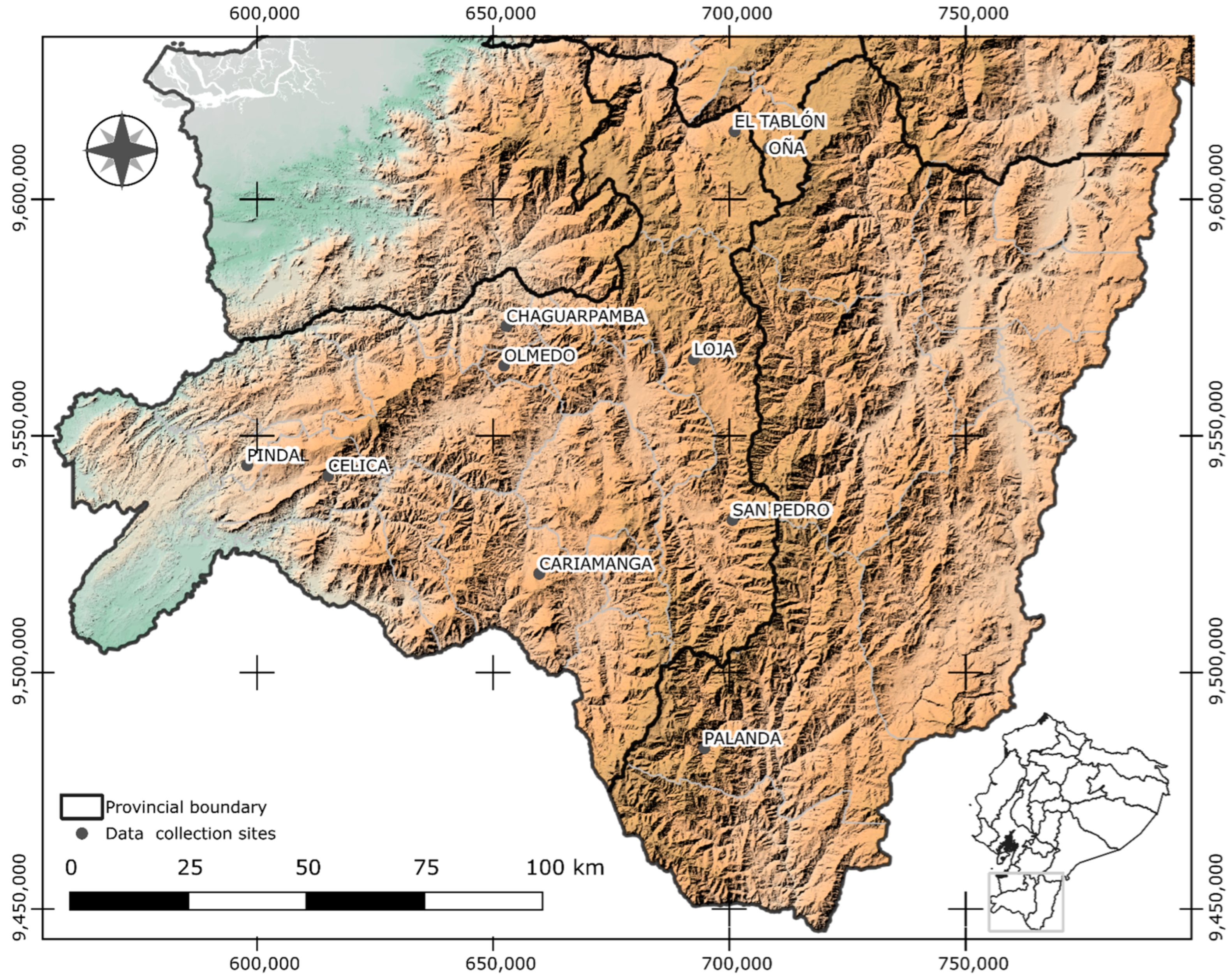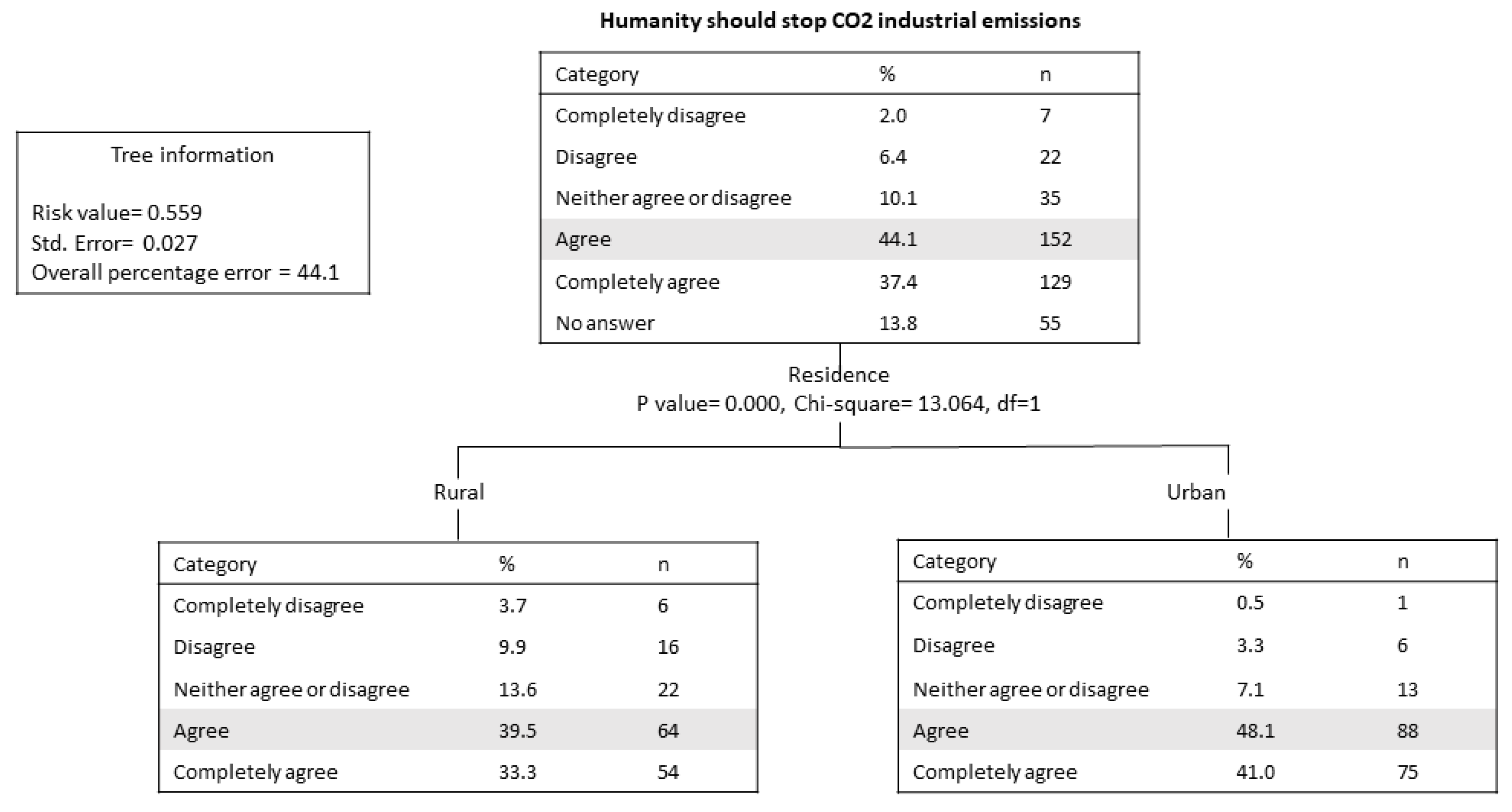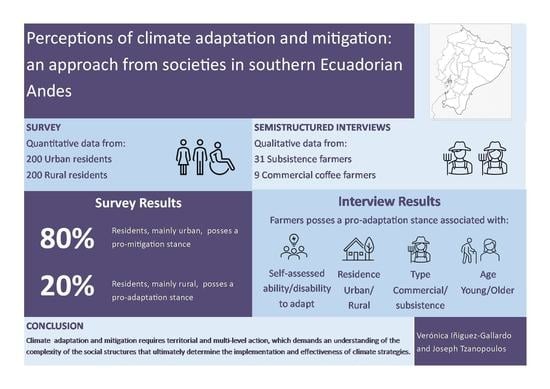Perceptions of Climate Adaptation and Mitigation: An Approach from Societies in Southern Ecuadorian Andes
Abstract
1. Introduction
2. Methodology
2.1. Study Area
2.2. Methods and Data Analysis
2.2.1. Face-to-Face Questionnaires
2.2.2. Semi-Structured Interviews
3. Results
3.1. Public Stance on Climate Adaptation and Mitigation
3.2. Farmers’ Perceptions of Adaptation
“You, who work for the universities, must get to know what we do in the countryside, so you will learn how to lead. Without resources but with much good willing and a bit of leadership, we have grown more. You need to create leaders with experience [in the countryside]. We don’t need office workers. Here is my finca [farm], you are welcome to do experiments with soil, just as I do…”[Commercial Farmer 1].
“One must adapt otherwise you will be screwed up… so it is… the whole world must adapt… When you work hard, there’s not such a thing as bad years… we must diversify the production, have an orchard to ensure our food. My father taught me to work hard and have the passion of everything I do”[Subsistence Farmer 7].
“Before it used to rain between October and November. Now it is November, and we just have the rain that soothes the land dryness. You must adapt to the temporal [weather]. If it starts raining in December, then you should start planting… If I wait until January, then I will be lost…”[Subsistence Farmer 23].
3.2.1. Observations of Weather Changes
3.2.2. Impacts of Climatic Changes in Agricultural Practices
3.2.3. Farmer’s Adaptive Responses to Climatic Changes
3.2.4. Determinants for Adaptive Responses
4. Discussion
5. Conclusions
Author Contributions
Funding
Institutional Review Board Statement
Informed Consent Statement
Data Availability Statement
Conflicts of Interest
References
- Azadi, Y.; Yazdanpanah, M.; Mahmoudi, H. Understanding smallholder farmers’ adaptation behaviors through climate change beliefs, risk perception, trust, and psychological distance: Evidence from wheat growers in Iran. J. Environ. Manag. 2019, 250, 109456. [Google Scholar] [CrossRef] [PubMed]
- Rühlemann, A.; Jordan, J.C. Risk perception and culture: Implications for vulnerability and adaptation to climate change. Disasters 2019, 45, 424–452. [Google Scholar] [CrossRef] [PubMed]
- Musacchio, A.; Andrade, L.; O’Neill, E.; Re, V.; O’Dwyer, J.; Hynds, P. Planning for the health impacts of climate change: Flooding, private groundwater contamination and waterborne infection—A cross-sectional study of risk perception, experience and behaviours in the Republic of Ireland. Environ. Res. 2021, 194, 110707. [Google Scholar] [CrossRef] [PubMed]
- Eriksen, S.H.; Nightingale, A.J.; Eakin, H. Reframing adaptation: The political nature of climate change adaptation. Glob. Environ. Chang. 2015, 35, 523–533. [Google Scholar] [CrossRef]
- Taylor, M. The Political Ecology of Climate Change Adaptation; Routledge: London, UK, 2015. [Google Scholar]
- Adaawen, S. Understanding climate change and drought perceptions, impact and responses in the rural Savannah, West Africa. Atmosphere 2021, 12, 594. [Google Scholar] [CrossRef]
- Carey, M. In the Shadow of Melting Glaciers: Climate Change and Andean Society; Oxford University Press: New York, NY, USA, 2010. [Google Scholar]
- Eisenstadt, T.A.; West, K.J. Indigenous Belief Systems, Science, and Resource Extraction: Climate Change Attitudes in Ecuador. Glob. Environ. Polit. 2017, 17, 40–58. [Google Scholar] [CrossRef]
- Hernández, J.R. Society, Environment, Vulnerability, and Climate Change in Latin America. Lat. Am. Perspect. 2016, 43, 29–42. [Google Scholar] [CrossRef]
- Iñiguez-Gallardo, V.; Jurrius, I. Vulnerabilidades Y Adaptación Al Cambio Climático De Usuarios De Manglar: Caso De Análisis De Manglares Del Sur Del Ecuador. In Manglares de América; Universidad Espíritu Santo: Guayaquil, Ecuador, 2019. [Google Scholar]
- Newell, P. Climate justice. J. Peasant Stud. 2022, 49, 915–923. [Google Scholar] [CrossRef]
- Shea, M.M.; Thornton, T.F. Tracing country commitment to Indigenous peoples in the UN Framework Convention on Climate Change. Glob. Environ. Chang. 2019, 5, 101973. [Google Scholar] [CrossRef]
- Araos, M.; Jagannathan, K.; Shukla, R.; Ajibade, I.; de Perez, E.; Davis, K.; Ford, J.; Galappaththi, E.; Grady, C.; Hudson, A.; et al. Equity in human adaptation-related responses: A systematic global review. One Earth 2021, 4, 1454–1467. [Google Scholar] [CrossRef]
- Yang, H.; Lee, T.; Juhola, S. The old and the climate adaptation: Climate justice, risks, and urban adaptation plan. Sustain. Cities Soc. 2021, 67, 102755. [Google Scholar] [CrossRef]
- Fierros-González, I.; López-Feldman, A. Farmers’ Perception of Climate Change: A Review of the Literature for Latin America. Front. Environ. Sci. 2021, 9, 672399. [Google Scholar] [CrossRef]
- Iwama, A.Y.; Araos, F.; Anbleyth-Evans, J.; Marchezini, V.; Ruiz-Luna, A.; Ther-Ríos, F.; Bacigalupe, G.; Perkins, P. Multiple knowledge systems and participatory actions in slow-onset effects of climate change: Insights and perspectives in Latin America and the Caribbean. Curr. Opin. Environ. Sustain. 2021, 50, 31–42. [Google Scholar] [CrossRef]
- Chipfupa, U.; Tagwi, A.; Wale, E. Psychological Capital and Climate Change Adaptation: Empirical Evidence from Smallholder Farmers in South Africa. Jamba J. Disaster Risk Stud. 2021, 13, 1–12. [Google Scholar] [CrossRef] [PubMed]
- Mairura, F.S.; Musafiri, C.; Kiboi, M.; Macharia, J.; Ng’etich, O.; Shisanya, C.; Okeyo, J.; Mugendi, D.; Okwuosa, E.; Ngetich, F. Determinants of farmers’ perceptions of climate variability, mitigation, and adaptation strategies in the central highlands of Kenya. Weather Clim. Extrem. 2021, 34, 100374. [Google Scholar] [CrossRef]
- Destaw, F.; Fenta, M.M. Climate change adaptation strategies and their predictors amongst rural farmers in Ambassel district, Northern Ethiopia. Jamba J. Disaster Risk Stud. 2021, 13, a974. [Google Scholar] [CrossRef]
- Cobbinah, P.B. Urban resilience in climate change hotspot. Land Use Policy 2021, 100, 104948. [Google Scholar] [CrossRef]
- Lyth, A.; Harwood, A.; Hobday, A.J. Place influences in framing and understanding climate change adaptation challenges. Local. Environ. 2016, 21, 730–751. [Google Scholar] [CrossRef]
- Maldonado, N.P. Clima y vegetación de la región sur del Ecuador. In Botanica Austroecuatoriana: Estudios Sobre Los Recursos Vegetales en Las Provincias de El Oro, Loja y Zamora-Chinchipe; Aguirre, Z., Madsen, J.E., Cotton, E., Balslev, H., Eds.; Abya Yala: Quito, Ecuador, 2002. [Google Scholar]
- MAE. Estrategia Nacional de Cambio Climático del Ecuador ENCC 2012–2025; MAE: Quito, Ecuador, 2012; pp. 1–156. [Google Scholar]
- MAE. Ecuador’s Response to the Challenges of Climate Change; MAE: Quito, Ecuador, 2017. [Google Scholar]
- Newing, H. Conducting Research in Conservation: A Social Science Perspective; Routledge: New York, NY, USA, 2011. [Google Scholar]
- IPCC. Climate Change 2021: Contribution of working Group I to the Sixth Assessment Resport of the Intergovernmental Panel on Climate Change; Masson-Delmotte, V., Zhai, P., Pirani, A., Connors, S., Péan, C., Berger, S., Caud, N., Chen, Y., Goldfarb, L., Gomis, M., et al., Eds.; Cambridge University Press: Cambridge, UK; New York, NY, USA, 2021. [CrossRef]
- Iniguez-Gallardo, V.; Bride, I.; Tzanopoulos, J. Between concepts and experiences: Understandings of climate change in southern Ecuador. Public Underst. Sci. 2020, 29, 745–756. [Google Scholar] [CrossRef]
- Saldaña, J. The Coding Manual for Qualitative Researchers; SAGE Publications: London, UK, 2013. [Google Scholar]
- Iniguez-Gallardo, V.; Boero Lenti, D.; Tzanopoulos, J. Climate change and emotions: An analysis of people ’ s emotional states in southern Ecuador. Front. Psychol. 2021, 12, 644240. [Google Scholar] [CrossRef]
- Kumar, P. Climate Change and Cities: Challenges Ahead. Front. Sustain. Cities 2021, 3, 645613. [Google Scholar] [CrossRef]
- Salick, J.; Fang, Z.; Byg, A. Eastern Himalayan alpine plant ecology, Tibetan ethnobotany, and climate change. Glob. Environ. Chang. 2009, 19, 147–155. [Google Scholar] [CrossRef]
- Turner, N.J.; Clifton, H. “It’s so different today”: Climate change and indigenous lifeways in British Columbia, Canada. Glob. Environ. Chang. 2009, 19, 180–190. [Google Scholar] [CrossRef]
- Seo, S.N.; Mendelsohn, R. An analysis of crop choice: Adapting to climate change in South American farms. Ecol. Econ. 2008, 67, 109–116. [Google Scholar] [CrossRef]
- Fahad, S.; Wang, J. Farmers’ risk perception, vulnerability, and adaptation to climate change in rural Pakistan. Land Use Policy 2018, 79, 301–309. [Google Scholar] [CrossRef]
- Campos, M.; Velázquez, A.; McCall, M. Adaptation strategies to climatic variability: A case study of small-scale farmers in rural Mexico. Land Use Policy 2014, 38, 533–540. [Google Scholar] [CrossRef]
- Wheeler, S.; Zuo, A.; Bjornlund, H. Farmers’ climate change beliefs and adaptation strategies for a water scarce future in Australia. Glob. Environ. Chang. 2013, 23, 537–547. [Google Scholar] [CrossRef]
- Martínez Valle, L. La necesidad de una nueva visión de desarrollo rural en el Ecuador. In Perspectivas de desarrollo rural en América Latina—2020; Salento University Publishing: Lecce, Italy, 2020. [Google Scholar]
- Iñiguez Gallardo, V.; Serrano Barbecho, R.; Reyes Bueno, F. Divergencias y convergencias para asegurar la actividad agrícola en Ecuador: Análisis de la parroquía Chuquiribamba (Loja). Eutopía—Rev Desarro Económico Territ. 2018, 14, 177–198. [Google Scholar] [CrossRef]
- Lowder, S.K.; Sánchez, M.V.; Bertini, R. Which farms feed the world and has farmland become more concentrated? World Dev. 2021, 142, 105455. [Google Scholar] [CrossRef]
- FAO. 2017. Available online: http://www.fao.org/ecuador/fao-en-ecuador/ecuador-en-una-mirada/es/ (accessed on 17 March 2022).
- Hasan, M.K.; Kumar, L. Comparison between meteorological data and farmer perceptions of climate change and vulnerability in relation to adaptation. J. Environ. Manag. 2019, 237, 54–62. [Google Scholar] [CrossRef]
- Oviedo Freire, A. Qué es el Sumak Kawsay: Mas Allá del Antropocentrismo de Derecha e Izquierda; Sumak Editores: Quito, Ecuador, 2017; p. 251. [Google Scholar]
- Biggs, R.; Schlüter, M.; Schoon, M.L. An introduction to the resilience approach and principles to sustain ecosystem services in social-ecological systems. In Principles for Building Resilience: Sustaining Ecosystem Services in Social-Ecological Systems; Cambridge University Press: Cambridge, UK, 2015. [Google Scholar]
- Martínez Valle, L. Rethinking rural-urban linkages: Villages and agribusiness in the Ecuadorian Highlands. J. Agrar. Chang. 2021, 21, 854–869. [Google Scholar] [CrossRef]
- Verner, D.; Kronik, J. Indigenous Peoples and Climate Change in Latin America and the Caribbean; Directions in Development; Environment and Sustainable Development; World Bank: Washington, DC, USA, 2010. [Google Scholar]
- Corral-Verdugo, V.; Pinheiro, J.Q. Environmental psychology with a Latin American taste. J. Environ. Psychol. 2009, 29, 366–374. [Google Scholar] [CrossRef]
- Aguirre Salas, A. La Masacre de Santa Ana: Una Historia de Arrimados, 1st ed.; Casa de la Cultura Ecuatoriana Benjamín Carrión Mora—Núcleo de Loja: Loja, Ecuador, 2018. [Google Scholar]
- Below, T.B.; Schmid, J.C.; Sieber, S. Farmers’ knowledge and perception of climatic risks and options for climate change adaptation: A case study from two Tanzanian villages. Reg. Environ. Chang. 2015, 15, 1169–1180. [Google Scholar] [CrossRef]
- Mbow, C.; Mertz, O.; Diouf, A.; Rasmussen, K.; Reenberg, A. The history of environmental change and adaptation in eastern Saloum–Senegal—Driving forces and perceptions. Glob. Planet. Chang. 2008, 64, 210–221. [Google Scholar] [CrossRef]
- Grothmann, T.; Patt, A. Adaptive capacity and human cognition: The process of individual adaptation to climate change. Glob. Environ. Chang. 2005, 15, 199–213. [Google Scholar] [CrossRef]
- Walker, B.; Salt, D. Resilience Practice: Building Capacity to Absorb Disturbance and Maintain Function; Island Press: Washington, DC, USA, 2012. [Google Scholar]
- Ensor, J.; Harvey, B. Social learning and climate change adaptation: Evidence for international development practice. WIREs Clim. Chang. 2015, 6, 509–522. [Google Scholar] [CrossRef]
- Thaker, J.; Maibach, E.; Leiserowitz, A.; Zhao, X.; Howe, P. The Role of Collective Efficacy in Climate Change Adaptation in India. Weather. Clim. Soc. 2016, 8, 21–34. [Google Scholar] [CrossRef]
- Sharifi, A. Co-benefits and synergies between urban climate change mitigation and adaptation measures: A literature review. Sci. Total Environ. 2021, 750, 141642. [Google Scholar] [CrossRef]
- Mertz, O.; Mbow, C.; Reenberg, A.; Diouf, A. Farmers’ perceptions of climate change and agricultural adaptation strategies in rural sahel. Environ. Manag. 2009, 43, 804–816. [Google Scholar] [CrossRef]
- Ishaya, S.; Abaje, I. Indigenous people’s perception on climate change and adaptation strategies in Jema’a local government area of Kaduna State, Nigeria. J. Geogr. Reg. Plan. 2008, 1, 138–143. [Google Scholar]
- Cobbinah, P.B.; Anane, G.K. Climate change adaptation in rural Ghana: Indigenous perceptions and strategies. Clim. Dev. 2016, 8, 169–178. [Google Scholar] [CrossRef]
- Howe, P.D.; Leiserowitz, A. Who remembers a hot summer or a cold winter? The asymmetric effect of beliefs about global warming on perceptions of local climate conditions in the U.S. Glob. Environ. Chang. 2013, 23, 1488–1500. [Google Scholar] [CrossRef]
- Tripathi, A.; Singh, G.S. Perception, anticipation and responses of people to changing climate in the gangetic plain of India. Curr. Sci. 2013, 105, 1673–1684. [Google Scholar]
- Sandoval-Díaz, J. Vulnerabilidad-resiliencia ante el proceso de riesgo-desastre: Un análisis desde la ecología política. Polis 2020, 19, 214–239. [Google Scholar] [CrossRef]





Disclaimer/Publisher’s Note: The statements, opinions and data contained in all publications are solely those of the individual author(s) and contributor(s) and not of MDPI and/or the editor(s). MDPI and/or the editor(s) disclaim responsibility for any injury to people or property resulting from any ideas, methods, instructions or products referred to in the content. |
© 2023 by the authors. Licensee MDPI, Basel, Switzerland. This article is an open access article distributed under the terms and conditions of the Creative Commons Attribution (CC BY) license (https://creativecommons.org/licenses/by/4.0/).
Share and Cite
Iñiguez-Gallardo, V.; Tzanopoulos, J. Perceptions of Climate Adaptation and Mitigation: An Approach from Societies in Southern Ecuadorian Andes. Sustainability 2023, 15, 1086. https://doi.org/10.3390/su15021086
Iñiguez-Gallardo V, Tzanopoulos J. Perceptions of Climate Adaptation and Mitigation: An Approach from Societies in Southern Ecuadorian Andes. Sustainability. 2023; 15(2):1086. https://doi.org/10.3390/su15021086
Chicago/Turabian StyleIñiguez-Gallardo, Verónica, and Joseph Tzanopoulos. 2023. "Perceptions of Climate Adaptation and Mitigation: An Approach from Societies in Southern Ecuadorian Andes" Sustainability 15, no. 2: 1086. https://doi.org/10.3390/su15021086
APA StyleIñiguez-Gallardo, V., & Tzanopoulos, J. (2023). Perceptions of Climate Adaptation and Mitigation: An Approach from Societies in Southern Ecuadorian Andes. Sustainability, 15(2), 1086. https://doi.org/10.3390/su15021086









